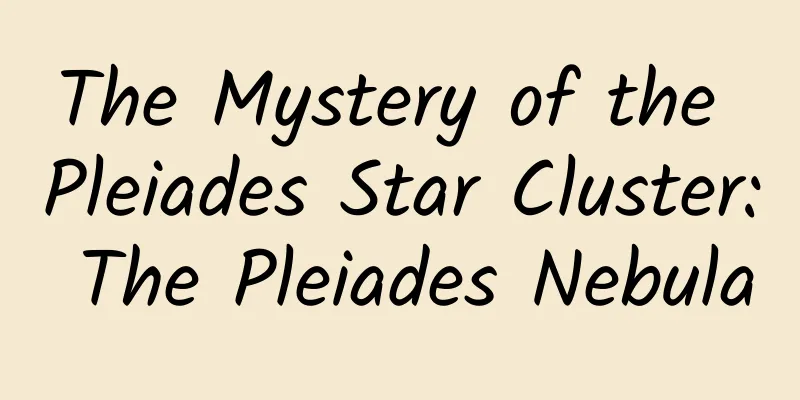The Mystery of the Pleiades Star Cluster: The Pleiades Nebula

|
Author | Wang Siliang Review | Zheng Chengzhuo Editor | Zhao Jingyuan The Pleiades, a bright star cluster visible to the naked eye, has attracted human attention since ancient times. However, the mysterious Pleiades Nebula, hidden in the Pleiades, was not unveiled until the 19th century. Today, let us explore the story of the Pleiades Nebula (NGC 1435) in the history of astronomy. The Pleiades star cluster. Image credit: ESA The Alcyone nebula was first discovered by German astronomer Wilhelm Tempel in Venice, Italy, on October 19, 1859, using a 10.5 cm Steinheil Refractor telescope. Tempel initially thought it was a comet, but he noticed the position of the "comet" had not changed during his second night of observations, which made him realize that it was not actually a comet, but a nebula orbiting near Alcyone. He submitted his discovery to the academic journal Astronomische Nachrichten in December 1860 and published it the following year, but a more detailed study was not published until 1862. Temple's discovery soon attracted the interest of other astronomers, but also brought controversy. German astronomer Heinrich d'Arrest failed to see the Pleiades nebula when observing it with the 11-inch Merz Refractor at the Copenhagen Observatory in 1862, which led him to believe that the brightness of the nebula might be variable, and proposed the hypothesis that it might be a "variable nebula". D'Arrest's view was partially supported by German astronomer Johann Schmidt. However, German astronomer Arthur Auwers and French astronomer Jean Chacornac and others also observed the nebula separately, and it did not show brightness changes. Their observations supported the view that large-aperture telescopes perform poorly when observing diffuse nebulae, and smaller-aperture telescopes are more likely to capture nebula details at lower magnifications. Temple's drawing of the Pleiades star cloud. Image source: Reference 1 As time went on, more and more astronomers joined in the observation of the Pleiades nebula. In 1863, Thomas Webb, a British amateur astronomer, observed the nebula with a 5.5-inch Clark Refractor telescope, further confirming its existence. In 1873, British astronomer Charles Grover proposed that the brightness variation of the nebula might be an illusion caused by the performance differences of different instruments. Telescopes with low magnification and a larger field of view can see diffuse nebulae more clearly, while high magnification makes the telescope's field of view smaller, which may lead to misjudgment. In March 1874, French astronomers Benjamin Baillaud and Charles André observed the Pleiades Nebula using a 31.6 cm Sécretan refractor telescope and recorded that the nebula had two "cores". Danish astronomer John Dreyer tried several times to observe the Pleiades star cloud at Birr Castle using the 72-inch telescope, the largest in the world at the time, but failed each time. On December 10, 1877, inspired by Irish astronomy enthusiast Lawrence Parsons, Dreyer tried again. Unlike before, this time he used an eyepiece with a larger field of view. He finally succeeded, and Dreyer left the following record: "I first saw a line between two stars, the background was obviously darker than that line; when I pointed it out to Lawrence Parsons, he also saw it, and could distinguish a faint border, forming an angle of about 40°." On December 27, Parsons observed it again and wrote: "I noticed it at first glance when I placed it in the center of the field of view." Nebula near the Pleiades, photographed by the Henry brothers in 1888. Image source: Reference 1 On November 16, 1885, French astronomers Paul Henry and Prosper Henry used a 33 cm telescope at the Paris Observatory to obtain a photo of the nebula around the Pleiades, followed by two more shots on December 8 and 9. The images they obtained not only clearly showed the nebula structure near Alcyone, but also discovered a new nebula, the Pleiades Nebula. The Pleiades Nebula is numbered NGC 1432 in the New General Catalog of Nebulae and Clusters, and is the only nebula discovered in the catalog by photographic methods. It is a bit regrettable that the images taken by the Henry brothers in 1885 have been lost, and now we can only see the images they took in 1888. Soon, American astronomer Edward Pickering said he had photographed these nebulae on November 3, 1885, but until he noticed the Henry brothers' image, he thought they were just defects in the photographic plate and missed the discovery of the Pleiades nebula. On October 24, 1886, British amateur astronomer Isaac Roberts took a three-hour photograph of the Pleiades. His observations showed that almost the entire Pleiades was surrounded by nebulae. Two months later, Roberts took another photo that confirmed the existence of these nebulae. The Pleiades star cluster photographed by Roberts on December 8, 1888. Image source: Reference 1 The discovery and controversy of the Pleiades Nebula revealed how 19th-century astronomers relied on meticulous observations and rich experience to gradually deepen their understanding of the nature of nebulae under limited instrument conditions, and also demonstrated the importance of academic exchanges. From Temple's discovery to the introduction of photography by the Henry brothers, each step was accompanied by technological innovation and the evolution of methodology. These disputes and dialogues promoted the development of observation technology and promoted people's understanding of observation conditions, instrument performance, and other aspects. This also shows that scientific exploration is a process of continuous evolution, accompanied by constant questioning and verification, and enriching cognition in controversy. Every technological innovation, every method improvement, and every confrontation of views are important driving forces for human exploration of the mysteries of the universe. References 1. Wolfgang Steinicke, Observing and Cataloging Nebulae and Star Clusters, From Herschel to Dreyer's New General Catalog (2010), p535-575. 2. Stephen James O'Meara, The super secret sky, Astronomy, https://www.astronomy.com/science/the-super-secret-sky/ For more questions about the Pleiades Nebula, please leave a message in the comment area and Xiaoxing will answer them for you one by one~ Follow the WeChat public account/Sina Weibo/Science Popularization China "Xingming Observatory" and walk through the stars with Xiaoxing to harvest romance~ |
>>: It doesn’t even eat sugar. How picky is this fungus?
Recommend
Opportunities for new species: Surrounded by powerful competitors, how did NetEase Cloud Music break through in the second half?
It is difficult for small teams or small companie...
Google announces Android Jetpack Compose is now available in Beta
Google has just announced through the Android Dev...
Every time the volume is loud but the sales volume is small. Will the new Chery Xingtu Xingji ET be different this time?
Chery is a very "mysterious" brand. If ...
Where should Apple go after the large-screen iPhone?
2014 was a mixed year for Apple . On the one hand...
Apple launches 3nm chip for the first time! Is it necessary for us to spend money on such expensive technology?
The digital circle has been very lively recently....
Why does the pink muhly grass, a popular internet celebrity from abroad, amaze the world?
Recently, the pink muhly grass has entered its be...
60 yuan per piece, exported to Dubai! Some people can show off a bowl of it by dipping it in soy sauce...
Entering June, it is the season for eating bayber...
Why did Lenovo get a great bargain by buying MOTO?
“Ownership of more than 2,000 patents and the rig...
It's settled! This thing that caused the Internet to crash will be cancelled in 2035!
Leap seconds will soon be history. In the current...
How much does it cost to be an agent for a homestay mini program in Hengshui?
Why should you be an agent for WeChat Mini Progra...
Latest | Data rankings of 56 mainstream information flow advertising platforms!
The following is the latest traffic ranking of 56...
Practical Post | Comprehensive analysis of “Zhihu channel distribution strategy”!
My first impression of Zhihu came from a question...
Neolithic "Meteor Hammer" Discovered!
Recently, Chen Zuhua, a citizen of Nanchang City,...
Frontier Express Station | Chinese scientists discovered molecular water in lunar soil for the first time, observed "time crystals" for the first time, and independently developed the first high-speed built-in...
Frontier Express Station, see the cutting-edge te...









